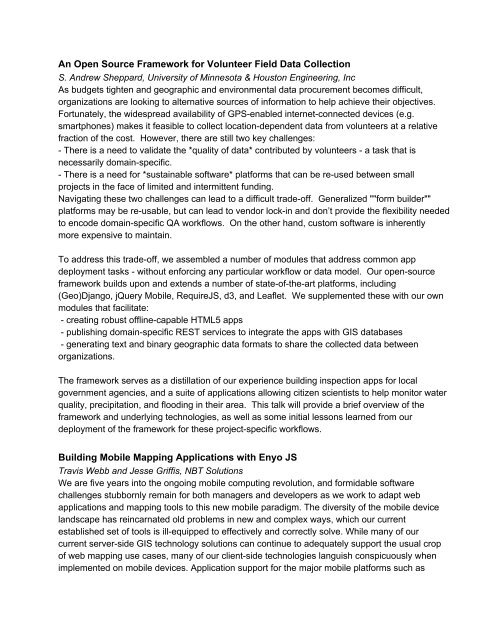FOSS4G North America Conference 2013 Preliminary Program
FOSS4G North America Conference 2013 Preliminary Program
FOSS4G North America Conference 2013 Preliminary Program
You also want an ePaper? Increase the reach of your titles
YUMPU automatically turns print PDFs into web optimized ePapers that Google loves.
An Open Source Framework for Volunteer Field Data Collection<br />
S. Andrew Sheppard, University of Minnesota & Houston Engineering, Inc<br />
As budgets tighten and geographic and environmental data procurement becomes difficult,<br />
organizations are looking to alternative sources of information to help achieve their objectives.<br />
Fortunately, the widespread availability of GPSenabled internetconnected devices (e.g.<br />
smartphones) makes it feasible to collect locationdependent data from volunteers at a relative<br />
fraction of the cost. However, there are still two key challenges:<br />
There is a need to validate the *quality of data* contributed by volunteers a task that is<br />
necessarily domainspecific.<br />
There is a need for *sustainable software* platforms that can be reused between small<br />
projects in the face of limited and intermittent funding.<br />
Navigating these two challenges can lead to a difficult tradeoff. Generalized ""form builder""<br />
platforms may be reusable, but can lead to vendor lockin and don’t provide the flexibility needed<br />
to encode domainspecific QA workflows. On the other hand, custom software is inherently<br />
more expensive to maintain.<br />
To address this tradeoff, we assembled a number of modules that address common app<br />
deployment tasks without enforcing any particular workflow or data model. Our opensource<br />
framework builds upon and extends a number of stateoftheart platforms, including<br />
(Geo)Django, jQuery Mobile, RequireJS, d3, and Leaflet. We supplemented these with our own<br />
modules that facilitate:<br />
creating robust offlinecapable HTML5 apps<br />
publishing domainspecific REST services to integrate the apps with GIS databases<br />
generating text and binary geographic data formats to share the collected data between<br />
organizations.<br />
The framework serves as a distillation of our experience building inspection apps for local<br />
government agencies, and a suite of applications allowing citizen scientists to help monitor water<br />
quality, precipitation, and flooding in their area. This talk will provide a brief overview of the<br />
framework and underlying technologies, as well as some initial lessons learned from our<br />
deployment of the framework for these projectspecific workflows.<br />
Building Mobile Mapping Applications with Enyo JS<br />
Travis Webb and Jesse Griffis, NBT Solutions<br />
We are five years into the ongoing mobile computing revolution, and formidable software<br />
challenges stubbornly remain for both managers and developers as we work to adapt web<br />
applications and mapping tools to this new mobile paradigm. The diversity of the mobile device<br />
landscape has reincarnated old problems in new and complex ways, which our current<br />
established set of tools is illequipped to effectively and correctly solve. While many of our<br />
current serverside GIS technology solutions can continue to adequately support the usual crop<br />
of web mapping use cases, many of our clientside technologies languish conspicuously when<br />
implemented on mobile devices. Application support for the major mobile platforms such as


